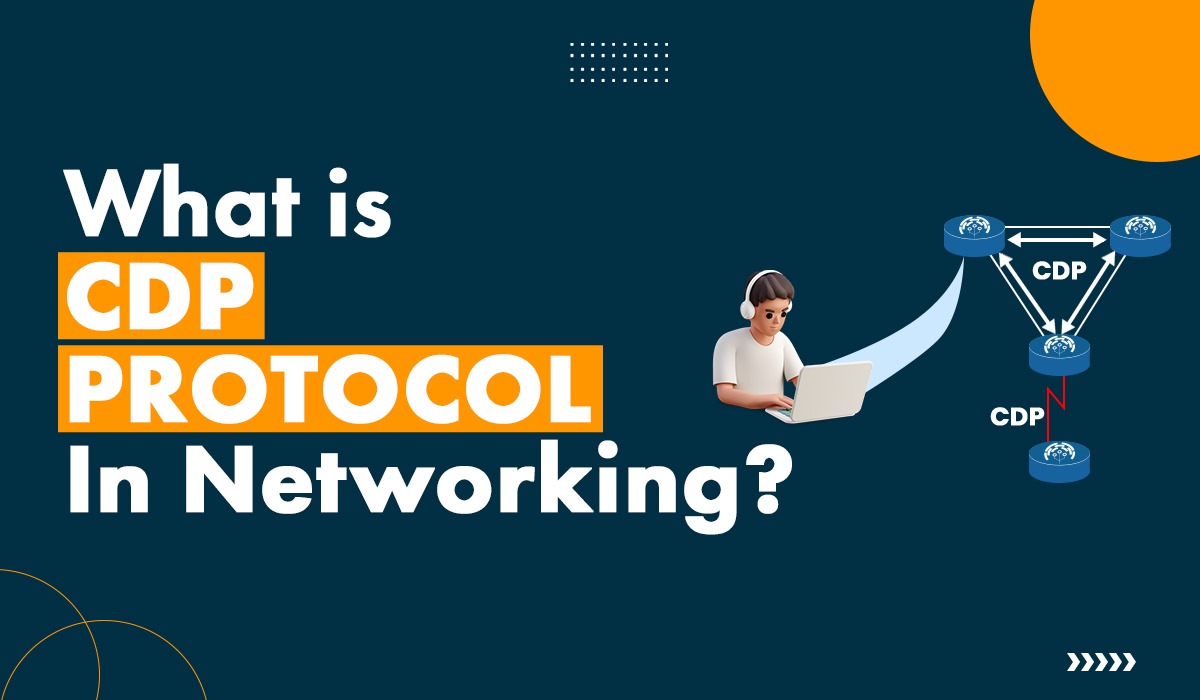Introduction
The digital landscape is constantly evolving, with networking protocols playing a pivotal role in ensuring seamless communication. One such protocol that stands out is the CDP (Cisco Discovery Protocol). In this comprehensive article, we delve into the intricacies of CDP, shedding light on its significance, functionality, and impact on networking landscapes. For those unfamiliar with networking terminologies, understanding what is CDP in networking becomes crucial to navigating the dynamic world of digital communication.
Understanding CDP in Networking
CDP is a proprietary data-link layer protocol developed by Cisco. It operates at the OSI model’s Layer 2, facilitating the detection and communication between Cisco devices within the same network. Unlike other protocols, CDP is Cisco-specific, offering unique advantages and features.
Importance of CDP Protocol
The incorporation of CDP into networking infrastructures holds paramount importance. Its ability to provide real-time information about connected Cisco devices aids network administrators in maintaining a robust and efficient network. Understanding the role of CDP is essential for optimizing network performance.
How CDP Works
CDP functions by allowing Cisco devices to share information about themselves with neighboring devices. This exchange includes details such as device type, capabilities, and the IP addresses of neighboring devices. This automatic discovery enhances network visibility and simplifies troubleshooting.
CDP vs. Other Networking Protocols
While CDP serves its purpose admirably, it’s essential to compare it with other networking protocols. This section explores the distinctions between CDP and other widely used protocols, highlighting the scenarios where CDP shines in the context of a comprehensive networking protocols list.
CDP often gets compared to LLDP (Link Layer Discovery Protocol). While both protocols serve the purpose of neighbor discovery, CDP’s Cisco-centric nature distinguishes it. Understanding these differences enables network administrators to make informed decisions based on their specific networking requirements.
Additionally, CDP’s integration with Cisco devices provides an edge in terms of seamless communication and compatibility. This nuanced comparison ensures a comprehensive understanding of when to opt for CDP over alternative protocols.
Key Features of CDP
To grasp the full spectrum of CDP’s capabilities, it’s crucial to delve into its key features. From dynamic neighbor discovery to platform and address information sharing, CDP’s features contribute significantly to network efficiency.
- Dynamic Neighbor Discovery: CDP enables devices to dynamically discover and communicate with their neighboring Cisco devices. This automatic process eliminates the need for manual intervention in identifying connected devices.
- Platform and Address Information Sharing: CDP goes beyond basic discovery by sharing detailed information about the connected device, including its platform type and configured network addresses. This wealth of information streamlines network management tasks.
- Automatic Topology Generation: By continuously exchanging information, CDP contributes to the automatic generation of network topology maps. This feature proves invaluable for network administrators in visualizing and optimizing network structures.
Benefits of Implementing CDP
The implementation of CDP comes with a myriad of benefits. Enhanced network visibility, streamlined troubleshooting, and improved device management are among the advantages that organizations can harness by integrating CDP into their networking infrastructure.
- Enhanced Network Visibility: CDP provides real-time insights into the network, allowing administrators to view connected devices, their types, and their capabilities. This visibility is crucial for maintaining an up-to-date inventory of network assets.
- Streamlined Troubleshooting: With CDP, identifying and addressing network issues becomes more efficient. The protocol’s continuous information exchange aids in troubleshooting by quickly pinpointing the location of potential problems.
- Improved Device Management: Knowing the details of connected devices empowers administrators to manage their network more effectively. From firmware updates to optimizing device configurations, CDP facilitates comprehensive device management.
Common Misconceptions about CDP
Despite its prevalence, misconceptions about CDP linger. This section dispels common myths, ensuring a clear understanding of CDP’s functionalities and dispelling any misinformation.
- CDP is Not Exclusive to Cisco Devices: While CDP is a Cisco-specific protocol, it doesn’t mean it can only communicate with Cisco devices. Many non-Cisco devices support CDP, enabling a broader scope of device recognition within a network.
- CDP Does Not Compromise Security: Some may worry that the information exchange in CDP could pose security risks. However, the protocol is designed with security in mind, and any potential vulnerabilities can be addressed through proper network security measures.
- CDP is More Than Just Neighbor Discovery: While neighbor discovery is a fundamental aspect, CDP’s capabilities extend to sharing detailed information about devices, contributing to a more robust network management system.
CDP in Practical Scenarios
Real-world applications showcase the practicality of CDP. Explore how CDP manifests in different scenarios, from large-scale enterprises to smaller networks, and understand its adaptability.
- Enterprise Networks: In large organizations with extensive network infrastructures, CDP plays a crucial role in maintaining visibility. It aids in managing a vast array of connected devices efficiently.
- Small and Medium-sized Businesses (SMBs): Even in smaller networks, CDP proves beneficial. It simplifies network management tasks, making it an ideal protocol for SMBs with limited IT resources.
- Network Expansion Projects: When expanding or reconfiguring a network, CDP’s automatic discovery simplifies the integration of new devices, ensuring a smooth transition without disruptions.
CDP Security Measures
Security is a paramount concern in networking, and CDP is no exception. This section delves into the security measures associated with CDP, ensuring a comprehensive understanding of its role in maintaining a secure network environment.
- Encrypted CDP: Cisco devices support encrypted CDP, adding a layer of security to the information exchange process. This ensures that sensitive information shared between devices remains confidential.
- CDP Authentication: Administrators can implement CDP authentication, requiring devices to provide credentials before participating in the information exchange. This measure adds an extra layer of protection against unauthorized access.
- Access Control Lists (ACLs): Implementing ACLs allows administrators to control which devices can participate in CDP exchanges, further securing the network.
Incorporating CDP into Network Design
For network architects and administrators, integrating CDP into the design is a strategic move. Discover best practices for seamless integration, optimizing network designs for efficiency and performance.
- Consider Device Compatibility: When designing a network, ensure that all devices support CDP or have alternative protocols in place. This compatibility ensures the seamless operation of CDP in the network.
- Optimize CDP Intervals: Fine-tuning the frequency of CDP information exchanges is essential. Adjusting intervals based on network size and dynamics contributes to efficient resource utilization.
- Training for Network Administrators: Providing training on CDP’s functionalities and best practices ensures that administrators can leverage the protocol to its full potential, enhancing overall network efficiency.
Future Trends in Networking Protocols
The dynamic nature of technology guarantees ongoing evolution. Explore future trends in networking protocols and speculate on how CDP might adapt to upcoming innovations.
- Integration with IoT Devices: As the Internet of Things (IoT) continues to grow, networking protocols, including CDP, may evolve to seamlessly integrate with a diverse range of IoT devices, contributing to comprehensive network management.
- Enhanced Security Measures: Anticipate advancements in CDP security measures, addressing emerging threats and vulnerabilities to ensure the protocol remains a reliable component of secure network infrastructures.
Frequently Asked Questions (FAQs)
What is the significance of CDP in networking?
CDP plays a crucial role in enhancing network visibility by providing real-time information about connected Cisco devices. This ensures efficient network management and troubleshooting.
Is CDP exclusive to Cisco devices?
Yes, CDP is a proprietary protocol developed by Cisco, making it exclusive to Cisco devices.
How does CDP contribute to network security?
CDP enhances network security by providing detailed information about connected devices, enabling administrators to identify and address potential security risks promptly.
Can CDP be disabled if needed?
While CDP is beneficial, it can be disabled if security concerns dictate, though doing so may impact network visibility and management.
Are there alternatives to CDP in networking?
Yes, several networking protocols serve similar purposes, such as LLDP (Link Layer Discovery Protocol). However, the choice depends on specific networking requirements and device compatibility.
How frequently does CDP exchange information between devices?
CDP typically exchanges information every 60 seconds, ensuring real-time updates about the network topology.
Conclusion
In conclusion, understanding the CDP protocol is pivotal for anyone navigating the intricacies of networking. From its inception by Cisco to its practical applications and future trends, CDP remains a cornerstone in optimizing network performance. As technology continues to advance, staying informed about protocols like CDP is key to staying ahead in the dynamic world of networking.
Also Read – digitalnomic









